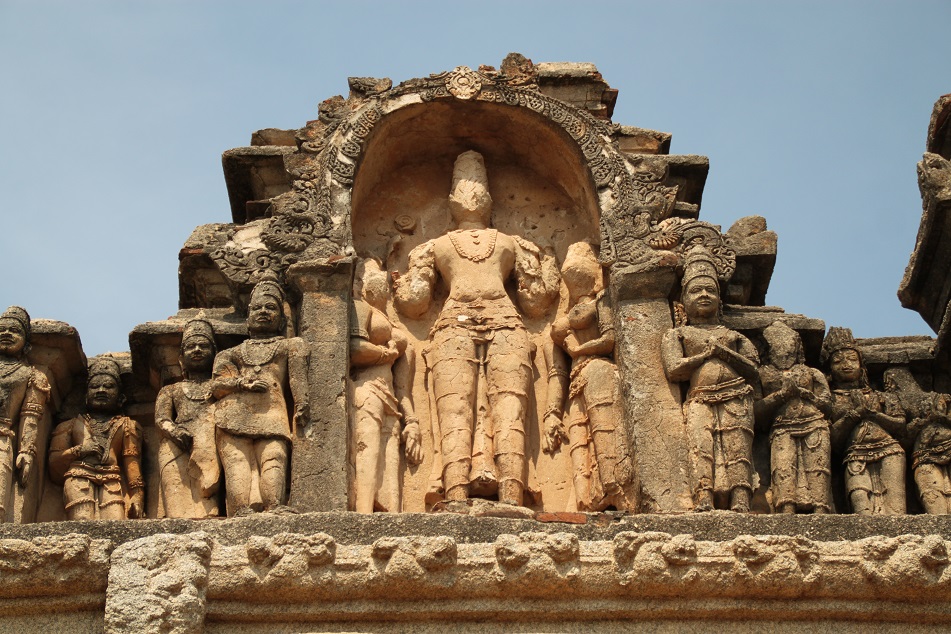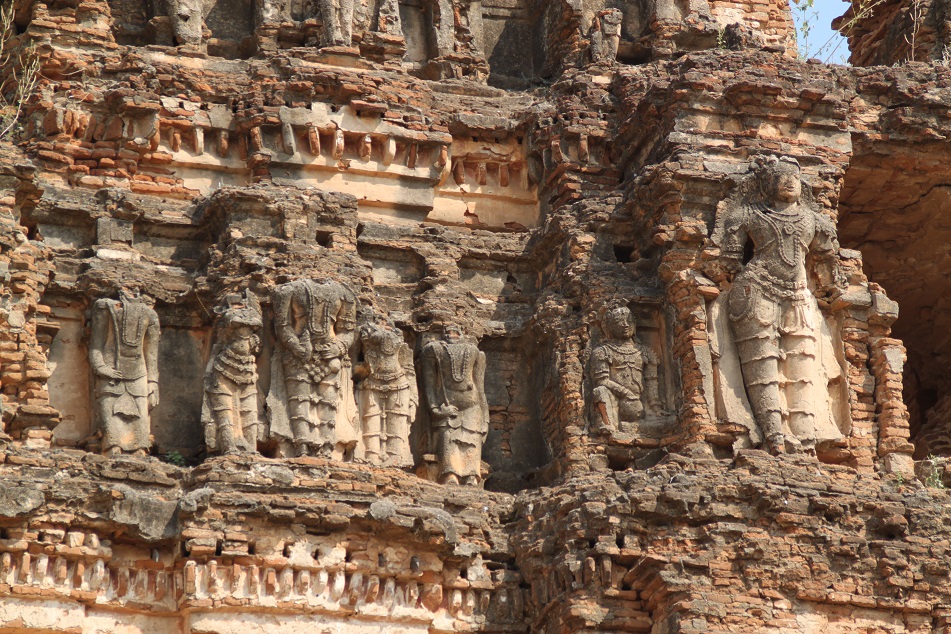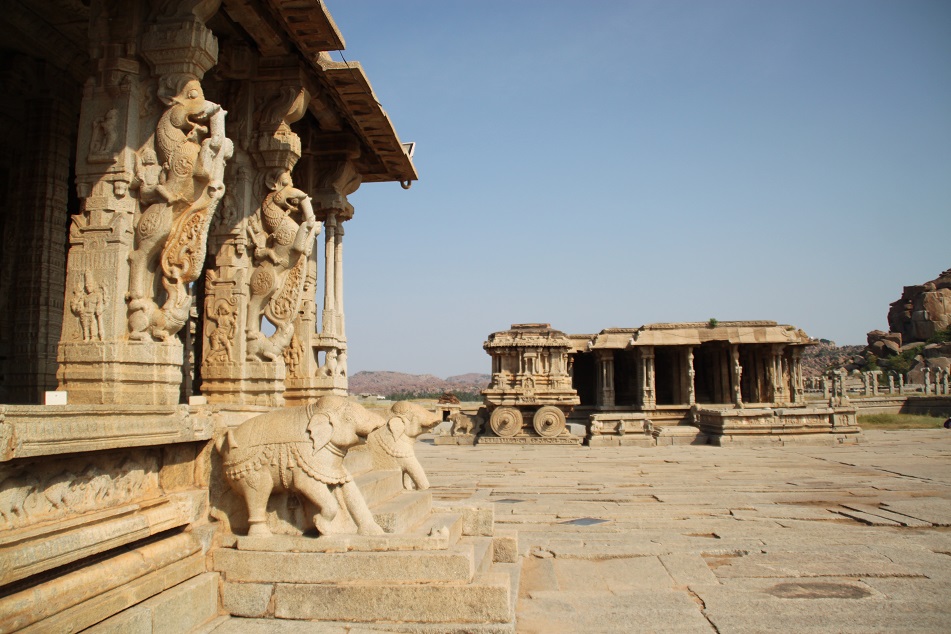Chapter 2, Part 2
In the 14th century Harihara I established Vijayanagara, a Hindu kingdom which would later become the most powerful empire in the history of South India, and Harihara II – the third king – conquered the Madurai Sultanate and vast swathes of land in the southern part of the subcontinent. Vijayanagara’s army marched on.
Two years after his father’s death, one of Harihara II’s sons, Deva Raya I, reigned the kingdom and began an era of rapid development. As the population grew, the increasingly powerful kingdom required more water to irrigate its rice paddies, therefore the urge for the new king to commission a series of irrigation works to ensure that his people, and more importantly his soldiers, well-fed. In religious affairs, he maintained a neutral position, providing justice and equal treatment to his subjects regardless their religion. In return, his people fully supported him in his military campaigns to further expand his territory.
As the society prospered, art flourished. Protected from the outside world by endless rocky outcrops surrounding the capital, as well as man-made forts, under Deva Raya I’s patronage sculptors and temple builders constructed Hazara Rama temple in the 15th century. Richly carved with scenes from the Hindu epic Ramayana, including images of Hanuman since Hampi is considered as the birthplace of the monkey warrior, Hazara Rama temple is also known for its distinct four polished blackstone pillars, embellished with images of characters from Ramayana, as well as those associated with Shiva and Vishnu. Vijayanagara’s early kings were in fact Shaivites (worshipers of Shiva), while the later kings were Vaishnavites who revered Vishnu the preserver.
Upon his death in 1422, Deva Raya’s sons – Ramachandra Raya and Vira Vijaya Bukka Raya – reigned for a brief period of time until Deva Raya II – the grandson of Deva Raya I – ascended the throne only two years after his grandfather’s death. The new king, however, was different from the previous two rulers who didn’t leave any notable mark to the kingdom. Deva Raya II turned out to be one of the greatest kings Vijayanagara ever had during its three centuries of existence.
Deva Raya II ruled Vijayanagara for more than two decades, during which he conquered Quilon in Kerala and Ceylon (modern-day Sri lanka), and fought against rival Muslim and Hindu powers to its north and northeast, respectively. He also commissioned the construction of Vittala temple, considered the most exquisite, ornate, and beautiful of all temples in Hampi.
Similar with other Vaishnavite temples where a statue of Garuda – vehicle of Vishnu – would sit in front of the main shrine, a structure was constructed in front of the Maha Mandapa, the temple’s main mandapa (pillared pavilion). Fashioned as a granite ratha (chariot) where an image of Garuda was enshrined, the Stone Chariot is today very emblematic to Hampi and the state of Karnataka for its unique style and elaborate reliefs.
Further additions to the temple were made by later kings, rendering Vittala temple an enduring beauty and elegance even long after its completion. One of the most unique features of the temple is Dolotsava Mandapa, the Musical Hall, named after its slender colonnettes which produce musical notes when struck with the fingers. This is caused by the different disposition of crystals that make up each pillar, not by the skill of the sculptors as some people might have guessed.
Vittala temple was only one of many jewels that adorned the capital of Vijayanagara during a period where the empire attained an unprecedented wealth and influence. Foreign explorers were intrigued by the news they heard of the magnificent empire, visited the capital themselves, and made extensive notes on the empire.
Niccolò de’ Conti, a merchant from Venice, came to Bizenegalia (Vijayanagara) shortly after the ascension of Deva Raya II. His journey from Venice to Damascus, Baghdad, Persia and Gujarat eventually brought him to the capital of Vijayanagara. He described the city to have an estimated of “ninety thousand men fit to bear arms”, and a festival where “they sprinkle all passers-by, even the king and queen themselves, with saffron water.”
Another explorer, Abdur Razzak from Persia, reached Bidjanagar twenty years after de’ Conti’s visit. Allured by the accounts he heard about the king of Vijayanagara who “has in his dominions three hundred ports, each of which is equal to Calicut, and on Terra Firma his territories comprise a space of three months’ journey”, the Persian embarked on his own journey to see with his own eyes what people had told him.
“At the end of the month of Zoul’hidjah (April 1443), we arrived at the city of Bidjanagar. The king sent an enormous cortege to meet us, and appointed us a very handsome house for our residence. His dominion extends from the frontier of Serendib (Sri Lanka) to the extremities of the country of Kalbergah (part of the Indian state of Karnataka). One sees there more than a thousand elephants, in their size resembling mountains and in their form resembling devils.”
“The city of Bidjanagar is such that the pupil of the eye has never seen a place like it, and the ear of intelligence has never been informed that there existed anything to equal it in the world. It is built in such a manner that seven citadels and the same number of walls enclose each other.”
On special occasions, including lunar and solar eclipses, the king was weighed against gold, gems and precious metals on the King’s Balance to the southwest of Vittala temple. The wealth was then distributed to the priests and those in need.
The prosperity of the kingdom not only was a boon to sculptors and temple builders, but also boosted other artistic developments, including festivals. All was made possible due to Vijayanagaran kings’ proclivity for art.
One of the most important festivals celebrated in ancient Vijayanagara was Dasara festival, also known as Mahanavami, a celebration of Durga’s victory over Mahishasura. This significant event in Hinduism was portrayed in the plethora of sculptures scattered all across South and Southeast Asia (in Indonesia it is known as Durga Mahisasuramardini). Cultural functions and performances were carried out during the ten-day festivity, and there was no place more fitting for a king and his queen to watch the festival other than an elaborately sculpted, elevated platform.
Mahanavami Dibba was constructed precisely for that reason. As one of many secular edifices in the kingdom, the three-tiered platform was decorated with reliefs of animals, hunting scenes, and Dravidian dancers, but missing the usual images of Hindu deities as well as characters from Ramayana and Mahabharata found at most ancient structures in the region.
Seated on the 12-meter platform looking to the east, erstwhile kings of Vijayanagara would gaze upon the faces of the dancers, performers, and everyone else before him with a sense of admiration and accomplishment as the sun on the west tinged them with warm, orange hue. The kingdom was at its golden period.
Click here for the full list of stories from the Spice Odyssey series.





























I really enjoyed the historical significance of the images. Thanks for sharing.
LikeLike
And thank you for reading. Much appreciated.
LikeLike
Photo dan ceritanya luar biasa, Bama. Bikin rindu dendam makin pengen ke Hampi. Maha Mandapanya bikin aku geleng2 kepala ngebayangin betapa hebatnya mereka pada jaman keemasan itu. Ga heran ya banyak yang terkagum2 gitu.
Nah itu stepwell-nya keren banget. Salah satu yg aku pengen liat di India termasuk pastinya adalaj vav yang ada di Gujarat… sempet kesana?
Btw, sampe ke Hampi via bangalore?
*kebanyakannanyahehe
LikeLike
Aduh mbak, udah rindu, dendam pula. Jangan bawa-bawa pisau ya.. 😀
Maha Mandapanya memang cantik banget mbak, tapi sayang pas saya di sana lagi direnovasi. Jadi cuma bisa lihat dari sekelilingnya. Kalau mau tau bunyinya musical pillar bisa dicari videonya di YouTube, tapi ya demi konservasi, sekarang udah dilarang. Mengenai stepwell, maksud mbak Riyanti Rani ki Vav kah? Itu stepwell yang paling pengen saya kunjungi. Sayang kemarin waktunya gak cukup buat ke Gujarat.
Saya ke Hampi dari Goa mbak. Naik kereta, turun di Hospet (kota terdekat dengan Hampi). Dari stasiun Hospet naik bajaj ke Hampi. Setelah dari Hampi baru ke Bangalore (yang macetnya gila-gilaan dan gak kalah sama Jakarta).
Hehe, gpp banyak ditanya. Banyak yang bisa di-share soalnya. Makasih udah baca ya mbak.
LikeLiked by 1 person
what a huge temple, with wonderful landscape
LikeLike
wonderful post, how i wish to travel to this region of india.
LikeLike
Thank you, Mukul. India is such a big and diverse country, and surely one needs to visit it several times to really experience the many faces of the country.
LikeLiked by 1 person
welcome. am still discovering the country
LikeLike
Holy smokes I just learned a lot! Thanks!
LikeLike
Thanks Cody & Liz. I’m glad this post gave you a little information on the history of this part of the world.
LikeLiked by 1 person
What an incredible place. Wonderful pictures to tell the story.
LikeLike
Hampi really is incredible, and the scale of the capital is mind-boggling. It’s easy to understand why erstwhile explorers who visited the city were astounded by what they saw. Thanks Marie.
LikeLiked by 1 person
I’m always impressed by these temples!
LikeLike
Those temples were indeed built to impress, Maja. Thanks for reading!
LikeLiked by 1 person
Awesome post!! I’ve been to southern india and ive no idea how i missed this! Fascinating….you’re amazing!
LikeLike
Thank you, Trees. There are so many places to see in southern India alone, and Hampi is quite far from major cities in the region. Well, now you know where to go the next time you’re in that part of India. 🙂
LikeLiked by 1 person
So beautiful, the levels of detail simply etched into the stone are phenomenal. These artisans from 700 years ago must have had a skill that is incomparable to any in today’s world
LikeLike
It always amazes me how advanced the craftsmanship of people who lived centuries, or even millennia, ago was. I often think about that too, the fact that somehow today some of those skills are lost. A visit to such magnificent place like Hampi can, at least, pique people’s interest in ancient arts.
LikeLiked by 1 person
Stunning account Bama! The details of the Hazara Rama temple are exquisite. As is the iconic Kallina Ratha. You might be intrigued to know that the ceremony you refer to where the king is weighed on a scale – it’s called Tulabharam in Sanskrit – is still followed as a form of offering in many temples in the South! Only the weights in use are distinctly less royal, usually rice, sugar, or coconuts 🙂
LikeLike
Thank you, Madhu! Kallina Ratha was THE structure that caught my attention when I read an article on Hampi many years ago. I don’t know why but it seems like I have a penchant for wheels at ancient temples — this, Airavatesvara, and the Sun Temple in Konark, for example. I actually did read about the modern-day ceremony. If Indonesia were still a Hindu nation probably we would have also used chilies and peanuts in addition to rice, palm sugar, and coconuts for the ceremony. 🙂
LikeLike
Haha, I ‘m sure! 🙂
LikeLike
I really enjoyed seeing the detail of the temples Bama. Incredulous to think of the efforts required to complete it.
LikeLike
We have modern technology to create things today — 3D printing for instance. So it was indeed a marvelous achievement that the sculptors and artisans of Vijayanagara could complete such intricate and beautiful temples. Thanks for reading, Sue.
LikeLike
As time goes by, I don’t know how you keep all your temples and pillars and kingdoms straight! What a rich trip you had and what deep and detailed research you have done!
LikeLike
At least that part of India doesn’t have to deal with frequent earthquakes and volcanic eruptions like Java, hence the better state of preservation of the ancient temples. That and the fact that a lot of those Hindu temples are still used by people today. As you can see, it really was an unforgettable trip, Lex. I would do such thing again in a heartbeat, but for now I’m happy with short trips every now and then. Thanks for sharing your thought!
LikeLiked by 1 person
Wow, so interesting about the musical hall! I can imagine an orchestra of people playing the pillars. Your last photo — this is where thali was served? Do you think people dining were seated on the grass and could be attended to by servers in the opening/walkway between the place settings? Your photos have captured my imagination in what day-to-day life would be like in a site like this. Amazing!
LikeLiked by 2 people
This is a video about the musical pillar: https://www.youtube.com/watch?v=NIdGQ8P49l4 You can see why such practice is forbidden by the government now for preservation purposes. Yes, that long slabs of stone were where people had their thali, and in the middle there’s a stream for people to wash their hands. I found it very fascinating that centuries later thali is still very much loved by Indians — some things never change in this constantly changing world. You should go to Hampi, Kelly, and explore all those temples and hills. Thanks for reading!
LikeLiked by 2 people
Bama, as usual your detailed historical accounts complement the photos so well. I did wonder why the King’s Balance got its name – thanks to this post we all know the intriguing story behind it! Vittala Temple was a marvel to behold. All that intricate detailing, the stone chariot whose wheels could once turn, and the idea of the musical pillars all speak volumes about the past greatness of this kingdom. Perhaps we should have gone first thing in the morning!
LikeLiked by 2 people
Despite its importance as the last major Hindu kingdom in southern India, historical accounts on some structures in Hampi are scarce, so I had to do a deeper research to write the posts on Vijayanagara. Can you imagine how Vittala Temple and its environs must have looked like during Krishna Deva Raya’s reign? Even today it still is a marvel to behold, as you said. Going first thing in the morning might have been a better idea, but the temple was magnificent nonetheless. Makasih James!
LikeLiked by 2 people
reading your posts is like watching an epic movie….the visuals appear right in front of my eyes
LikeLiked by 2 people
That’s a really kind of you to say, Sree. I wonder if one day there will be an epic movie about Vijayanagara, just like they did Bahubali.
LikeLiked by 3 people
oh..wow..so you have seen Bahubali?? that’s cool
LikeLiked by 2 people
I saw the trailer when I was traveling in India, but I haven’t watched the movie yet. I guess when I go back to Jakarta I will look for it.
LikeLiked by 3 people
Pingback: Kochi: From Spices to Kathakali | What an Amazing World!
Pingback: Thanjavur and the Doctrine of Lapse | What an Amazing World!
Pingback: Batak: From Cannibalism to Christianity | What an Amazing World!